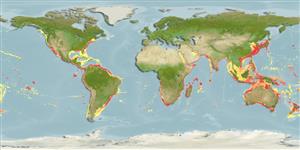>
Carangiformes (Jacks) >
Carangidae (Jacks and pompanos) > Naucratinae
Etymology: Seriola: Latin word diminutive with the meaning of a large earthenware pot (Ref. 45335).
More on author: Valenciennes.
Issue
Junior synonyms Seriola aureovittata Temminck and Schlegel, 1845 (in Japan, Northwest Pacific) and Seriola dorsalis (Gill, 1863) (in California, Pacific Baja, and the Gulf of California, Mexico; Northeast Pacific ) are considered valid with Seriola lalandi Valenciennes 1833 confined in Brazil, South Africa, Australia, New Zealand, and Chile (Southern distribution only), according to Martinez-Takeshita et al., 2015 (Ref. 121056).
Environment: milieu / climate zone / depth range / distribution range
Ecologia
marinhas; estuarina bentopelágico; intervalo de profundidade 3 - 825 m (Ref. 4517). Subtropical; 18°C - 24°C (Ref. 6390); 55°N - 57°S, 180°W - 180°E
Circumglobal in subtropical waters: Series of disjunct populations. Indo-Pacific: South Africa, Walter Shoals, Amsterdam Island, Japan, Australia, New Zealand, New Caledonia, Hawaii, Rapa, Pitcairn Island, and Easter Island. Eastern Pacific: British Columbia, Canada to Chile (Ref. 2850), including Desventuradas Is. and Juan Fernández Is. (Ref. 89357). Eastern Atlantic: St. Helena, South Africa (Ref. 7097).
Comprimento de primeira maturação / Tamanho / Peso / Idade
Maturity: Lm ?, range 51 - ? cm
Max length : 250 cm TL macho/indeterminado; (Ref. 27865); common length : 80.0 cm TL macho/indeterminado; (Ref. 9137); peso máx. publicado: 96.8 kg (Ref. 40637); idade máx. registrada: 12 anos (Ref. 72462)
Espinhos dorsais (total): 5 - 6; Raios dorsais (total): 33-35; Espinhos anais 2-3; Raios anais : 20 - 21. The only jack without scutella on the caudal peduncle. Dark blue dorsally and almost white ventrally; with a well defined line of demarcation between the two colors.
Adults are benthopelagic in coastal and oceanic waters, off kelp beds and rocky areas (Ref. 2850), sometimes entering estuaries (Ref. 9563). They are solitary or in small groups and can be found near rocky shores, reefs and islands (Ref. 6390). Schools of juveniles are generally found in offshore waters, often near or beyond the continental shelf (Ref. 27865). They prefer warmer water (18-24°C) although they are occasionally found in cooler water (Ref. 27128). Adults feed on small fish, squid and crustaceans (Ref. 27121). Marketed fresh and salted or dried (Ref. 9283).
Paxton, J.R., D.F. Hoese, G.R. Allen and J.E. Hanley, 1989. Pisces. Petromyzontidae to Carangidae. Zoological Catalogue of Australia, Vol. 7. Australian Government Publishing Service, Canberra, 665 p. (Ref. 7300)
Status na Lista Vermelha da UICN (Ref. 130435)
Uso pelos humanos
Warning: mysqli::__construct(): (HY000/1040): Too many connections in /var/www/html/includes/func_getlabel.php on line 46
Can't connect to MySQL database (fbapp). Errorcode: Too many connections
